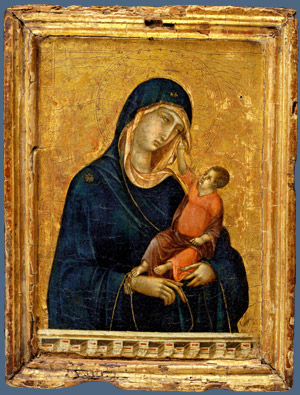- Madonna and Child (Duccio)
Infobox Painting|

title=Madonna and Child
artist=Duccio di Buoninsegna
year=c. 1300
type=Tempera
height=27.9
width=21
city=New York
museum=Metropolitan Museum of Art "Madonna and Child" (also known as the "Stoclet Madonna" or "Stroganoff Madonna") is a
panel painting byItalian medieval artist Duccio di Buoninsegna. Painted intempera withgilding on wood panel around the year 1300, it depictsMary, the mother of Jesus holding the infantJesus . Including the engaged frame, the work measures 27.9 x 21 centimeters.In November 2004 the painting was purchased by the
Metropolitan Museum of Art inNew York City (Met) for an undisclosed sum, reported to be in excess of 45 million USD, the most expensive purchase ever by the museum. It was the first work by Duccio acquired by the Met, which bought the painting from members of theStoclet family in order to close a gap in its permanent collections of painting. Works by Duccio, who is considered one of the pre-eminent painters of [Sienese medieval] painting, are extremely rare, with only a dozen or so known to survive; before the Met's purchase this was the last piece still in private hands. The painting is one of the few Duccio's known to be created as an individual work of art, and not part of an ensemble.The painting is sometimes called the "Stoclet Madonna", after the family name of
Adolphe Stoclet , its second recorded owner, who was a Belgianindustrialist in the early 20th century. The Met refers to the painting as the "Stroganoff Madonna" after its first recorded owner, CountGrigorii Stroganoff , a serious collector of early Italian paintings who died inRome in 1910. Stoclet acquired the painting following Stroganoff's death. After Stoclet and his wife died in 1949, the painting was willed to their son, Jacques. His four daughters inherited the painting from his widow in 2001. Through a sale arranged byChristie's , the daughters transferred ownership to the Met.Controversy
The late James Beck, Professor of Art History at
Columbia University in New York, believed that Duccio’s "Madonna and Child", which the Met dates to 1300, is the work of a 19th century artist or forger based on stylistic grounds. He pointed to what he considers to be the low quality of the painting and elements of content that he claims had not yet appeared in artwork of that period. Professor Beck said: "We are asked to believe that the modest little picture represents a leap into the future of Western painting by establishing a plane in front of Mary and the Child. This feature, a characteristic of Renaissance not Medieval pictures, occurs only a hundred years after the presumptive date of the picture ...". Beck's conclusions were posthumously published in 2007 in his book, "From Duccio to Raphael: Connoisseurship in Crisis" in which he also reportedly disputes the attribution of the National Gallery of London's painting "Madonna of the Pinks " toRaphael .Keith Christiansen, the Met's curator of European paintings, disagrees with Beck's contention. Christiansen has noted that, in addition to stylistic analysis of the painting in relation to other known works by the painter, the museum conducted a thorough examination of the painting, including the wooden panel's construction, the painting's
underdrawing andpigment composition and found them consistent with an attribution to Duccio and a date of around 1300. Christiansen said: "What everyone else sees as a sign of quality and innovation, Beck sees as weakness. There is no reason to doubt the period and authenticity of the picture." [http://www.timesonline.co.uk/article/0,,11069-2257809,00.html]References
*Hond, Paul. [http://www.columbia.edu/cu/alumni/Magazine/Fall2006/beck.html "College Walk: A Hanging at the Met".] "Columbia Magazine", Fall 2006.
*Tomkins, C. (July 11 &July 18 2005 ). [http://www.newyorker.com/fact/content/articles/050711fa_fact "The Missing Madonna: The story behind the Met's most expensive acquisition".] "The New Yorker".External links
* [http://www.metmuseum.org/Works_of_Art/viewOne.asp?dep=11&viewmode=0&item=2004.442 The Metropolitan Museum of Art's page about Duccio's "Madonna and Child"]
Wikimedia Foundation. 2010.
